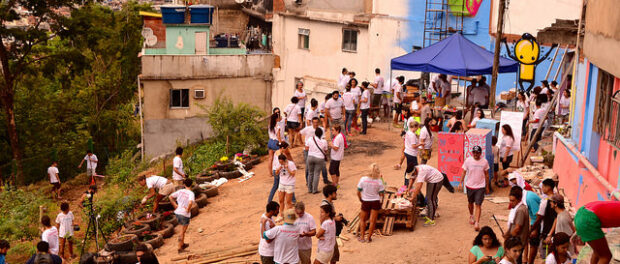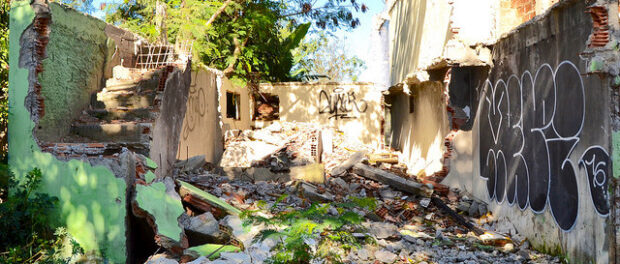
This is the second in a five-part series titled Housing Policy Lessons from Rio’s Favelas. We hope this series will inform debates on housing and favela upgrading and that Rio’s new mayor, Marcelo Crivella, will design policies that address the challenges favelas face while recognizing and strengthening their attributes, by actively engaging with residents in policy design and implementation.
Lesson 3: Relationships in communities rely on a sense of collective action
Favelas were born out of a tradition of collective action that dates back to slavery. Although the makeup of favelas has morphed and changed over the past century, understanding and recognizing their collective nature is critical to making policies that govern them.
“Here people get to know each other well on the street. If you go to the bakery to buy bread, someone is going to start talking to you. If you say ‘yeah I am living here,’ or if you like to drink a beer and go to a bar, you will already make a thousand friends.” – Cabritos, South Zone
Many favela residents refer to interactions between neighbors in the community as familial, giving a notion that there is a specific bond that is formed between residents. Whereas people in the formal city often live isolated from neighbors, people in favelas get to know each other through frequent interactions in the communities’ public spaces and shops, through long-standing familial or friend networks, and reliance on mutual support.
“The best thing we have in the favela is the collective spirit.” – City of God, West Zone
Enacting collective policies such as collective titling, emphasizing participation and strengthening the network of neighborhood associations would provide a link between informal and formal government institutions. Such policies could preserve local identity and build on the collective nature of these communities while reducing costs and increasing affordability and thus boosting residents’ ability to break out of poverty.
Lesson 4: Policies do not deliver promised services
Branded as an all-encompassing favela-upgrading program with the stated aim of upgrading all favelas by 2020, Morar Carioca’s actual delivery has been negligible. Some academics go as far as to say that “you can count on your fingers the favelas that have Morar Carioca” and community leaders called the project “shameful.”
“[Morar Carioca] is a shame. That this project is winning awards is even more shameful still. The reality is no dialogue at all. They changed the project various times. When you are going to make a change in this type of project, you have to ask the residents again. Nothing like this was done. Nothing like this was realized. Like everything that comes with the state here, it comes from the top down.” – Babilônia, South Zone
The policy solutions that will be successful in favela upgrading are ones that involve not only comprehensive infrastructure delivery, but also consistent and meaningful participation measures. Although such measures are already required in current policies, they are not delivered. The next mayoral administration must deliver heavily participatory upgrades to make up for the deep mistrust between communities and the city government.
“You have to have public policies that the state and city put in to become a community. You have to have schooling for everyone, a hospital to attend to people, public transport, and basic sanitation. That is a community. We still consider ourselves a favela because there aren’t public policies here for even half the residents. They count the residents incorrectly. They do a superficial count that they imagine and don’t go door-to-door to get a sense of how many people there are. We lack everything here, especially schools.” – Complexo do Alemão, North Zone
Meaningful participation in forming such policies is crucial to their success. Residents understand when participation mechanisms are added to a project to “check a box.” However, residents also understand the City must be involved in some capacity and that it can be useful in planning, regulating, giving technical support, as well as financial help, to projects.
“The city announced an upgrading plan (as part) of the Olympics for all the favelas in Rio. Did you know that it vanished? The first plan the city turned in didn’t even enter and Morar Carioca practically disappeared. You can count on your fingers the favelas that have Morar Carioca.” – Rio de Janeiro Federal University’s Institute of Urban and Regional Planning Research (UFRJ/IPPUR)
Education, health services, access to transport, leisure spaces and especially sanitation are all issues equally as important as housing. In fact, although residents spoke easily about the difficulties and obstacles of constructing homes, when it came to policies, responses were mainly about the lack of holistic services.
“There is this whole issue of Minha Casa Minha Vida (public housing) that when the apartments are constructed, they are constructed without thinking. I think because they think, ‘a home is the only thing they need.’” – Cabritos, South Zone
After collectively monitoring the launch and decline of Morar Carioca on RioOnWatch, it has become clear that the beautifully written program was mismanaged for political gain. In Babilônia, seen as a model for Morar Carioca’s implementation, community leaders today view the policy with disdain. In Pica-Pau in the North Zone, residents were promised Morar Carioca projects nearly five years ago in 2011, however, it was only launched, apparently as an electioneering exercise, in 2016.
This type of political maneuvering is not new in Rio’s favelas and has been common for decades, but accountability measures must be upheld to ensure that future favela upgrading policies are executed correctly. Policy design for housing and upgrading must be flexible and account for the important differences between favelas. Residents and community leaders know the needs of one community will be different to another.
“Is Alemão the same size as City of God? No, it is much larger. So, the policies can’t be thought of the same. These things are thought about as if you were to buy a small t-shirt for a person that is a large. It has to fit. From there, they come to half of the favela and don’t finish the rest. So this one has a little and that one has nothing.” – City of God, West Zone
The location of the community within the city is crucial in determining the level of services it may still need. Communities in the South Zone have greater access to jobs and formal infrastructure, whereas communities in the West Zone are newer and lack access to formal infrastructure channels.
“We know our needs. Since we know our needs, the social projects have to be from the communities themselves. This is because each community has a different characteristic. I know what we need for Vidigal, well not only me, but the association knows what Vidigal needs and other communities are the same. The projects have to be internal to external, not external to internal. This would be a huge advance.” – Vidigal, South Zone
Size is also another factor that affects the needs of a community. Smaller communities like Asa Branca or Cabritos may have a greater concentration of dynamic relationships where everyone knows each other. These could be used to aid the process of community planning and participation. However, larger communities like Rocinha, which has numerous associations, and Complexo do Alemão, which is made up of 13 communities, have their different challenges that come with scale.
Many of the South Zone communities are on steep hills with wonderful views, which affects how difficult building is in those communities. It also means that the communities are sensitive to real estate speculation. Communities in the West and North Zones, however, may be flatter, have fewer problems with construction and may view formal land titling as an improvement on their security of housing or increased access to credit.
“We do things here that we didn’t even think was possible because we know that it is a collective. I can do a little and another group can do a little. The story of the favela comes from this. I think the biggest difficulty is the lack of fortification of institutions at the community level.” – City of God, West Zone
To be successful, a policy must be able to adapt to these differences. To accomplish this flexibility, residents, with the help of the City, must map favela assets, which makes policy prescriptions clearer. By first acknowledging what each community already has, policies can be tailored to address challenges of each community, while preserving and strengthening assets, thus resulting in empowering outcomes. Citizens of these communities should play an active leadership role in designing these policies.
Full Series: Housing Policy Lessons from Rio’s Favelas
Part 1: Construction and Community
Part 2: Collective Action and Diverse Needs
Part 3: Distrust, Gentrification and Titling
Part 4: Public Housing
Part 5: Proposing Solutions


